Species Identification and Tempo-Spatial Distribution of Anchovy Using Multi-Frequency
Abstract
1. Introduction
2. Materials and Methods
2.1. Survey Area and Period
2.2. Acoustic Equipment System and Data Acquisitions
2.3. Acoustic Data Analysis
2.4. Estimating the Density of Anchovies Using Acoustics Methodology
3. Results
3.1. Species Identification of Anchovies
3.2. Temporal and Spatial Distribution of Anchovies
4. Discussion
5. Conclusions
Author Contributions
Funding
Institutional Review Board Statement
Informed Consent Statement
Data Availability Statement
Acknowledgments
Conflicts of Interest
References
- Kim, M.J.; Youn, S.H.; Kim, J.Y.; Oh, C.W. Feeding characteristics of the Japanese anchovy, Engraulis japonicus according to the distribution of zooplankton in the coastal waters of southern Korea. Korean J. Environ. Biol. 2013, 31, 275–287. [Google Scholar] [CrossRef]
- Lee, C.R.; Park, C.; Moon, C.H. Appearance of cold water and distribution of zooplankton off Ulsan-Gampo area, eastern coastal area of Korea. Sea J. Korean Soc. Ocean. 2004, 9, 51–63. [Google Scholar]
- Kang, M.H.; Seo, Y.I.; Oh, T.Y.; Lee, K.H.; Jang, C.S. Estimating the biomass of anchovy species off the coast of Tongyeong and Yeosu in South Korea in the spring and winter of 2013 and 2014. J. Korean Soc. Fish. Technol. 2015, 51, 86–93. [Google Scholar] [CrossRef]
- NFRDI. National Institute of Fisheries Science. 2022. Available online: https://www.mof.go.kr/doc/ko/selectDoc.do?docSeq=49328&searchDeptName=&meuSeq=971&searchEndDate=&searchEtc1=&searchEtc2=&searchEtc3=&searchEtc4=&searchEtc5=&curentPageNo=1&searchSelect=content&searchStartDate=&recordCountPerPage=&bbsSeq=10&searcValue=%EA%B8%B0%ED%9B%84 (accessed on 7 July 2023).
- Han, I.; Oh, W.; Yoon, E.A.; Suh, Y.; Lee, K.; Shin, H. The relationship between fish and zooplankton in south-western region of the East Sea using hydro-acoustics. J. Korean Sci. Fish. Ocean Technol. 2017, 53, 376–385. [Google Scholar] [CrossRef]
- Kang, D.H.; Hwang, D.J.; Mukai, T.; Iida, K.; Lee, K.H. Acoustic target strength of live Japanese common squid (Todarodes pacifica) for applying biomass estimation. J. Korean Fish. Aquat. Sci. 2004, 37, 345–353. [Google Scholar] [CrossRef]
- Yoon, S.C.; Youn, S.H.; Shim, M.J.; Woon, Y.Y. Characteristics and variation trend of water mass in offshore of the east coast of korea during last 10 year. J. Korean Soc. Mar. Environ. 2017, 20, 193–199. [Google Scholar] [CrossRef]
- Yang, Y.S.; Lee, K.H.; Hwang, B.K.; Lee, H.; Kim, I.O.; Kim, S. Backscattering strength and vertical distribution of dominant fishes in inland waters by hydroacoustics. J. Korean Soc. Fish. Technol. 2004, 50, 476–486. [Google Scholar] [CrossRef]
- Choi, S.G.; Yoon, E.A.; Han, I.; Oh, W. Comparison of Echogram Analysis Methods for Evaluating the Sound-scattering Layer. J. Korean Fish. Aquat. Sci. 2016, 49, 856–861. [Google Scholar]
- Kang, M.; Furusawa, M.; Miyashita, K. Effective and accurate use of difference in mean volume backscattering strength to identify fish and plankton. ICES J. Mar. Sci. 2002, 59, 794–804. [Google Scholar] [CrossRef]
- Miyashita, K.; Aoki, I.; Seno, K.; Taki, K.; Ogishima, T. Acoustic identification of isada krill, Euphausia pacifica Hansen, off the Sanriku coast, north-eastern Japan. Fish. Oceanogr. 1998, 6, 266–271. [Google Scholar] [CrossRef]
- McKelvey, D.R.; Wilson, C.D. Discriminant classification of fish and zooplankton backscattering at 38 and 120 kHz. Trans. Am. Fish. Soc. 2006, 135, 488–499. [Google Scholar] [CrossRef]
- Yoon, G.D.; Kim, Z.G.; Choi, Y.M. Acoustic Target Strength of the Pelagic Fish in the Southern Waters of Korea I. In situ Measurement of Target Strength of Anchovy (Engraulis japonica). J. Korean Soc. Fish. Technol. 1996, 29, 107–114. [Google Scholar]
- Park, G.C.; Han, I.S.; Oh, W.S.; Lee, K.H. Analysis on the estimating of fishery resources using hydro-acoustic. J. Korean Soc. Fish. Technol. 2022, 58, 223–229. [Google Scholar] [CrossRef]
- Jolly, G.M.; Hampton, I. A stratified random transect design for acoustic surveys of fish stocks. Can. J. Fish. Aquat. Sci. 1990, 47, 1282–1291. [Google Scholar] [CrossRef]
- Zhao, X.; Wang, Y.; Dai, F. Depth-dependent target strength of anchovy (Engraulis japonicus) measured in situ. ICES J. Mar. Sci. 2008, 65, 882–888. [Google Scholar] [CrossRef][Green Version]
- Zhu, D.S.; Iversen, S.A. Anchovy and other fish resources in the Yellow Sea and East China Sea. Mar. Fish. Res. 1990, 11, 1–143. [Google Scholar]
- Lee, C.I.; Jang, L.H.; Park, S.E. Influence of water temperature during the main spawning period on anchovy catch. J. Korean Fish. Aquat. Sci. 2009, 42, 297–301. [Google Scholar] [CrossRef]
- Moon, S.Y.; Baeck, G.W.; Lee, M.H.; Kim, H.Y.; Jung, K.M. Reproductive Characteristics of Pacific Anchovy Engraulis japonicus from the Southern Waters of Korea. J. Korean Fish. Aquat. Sci. 2022, 55, 927–937. [Google Scholar]
- Lee, E.K.; Yoo, J.M.; Kim, S.; Lee, Y.C. Verical distribution of anchovy, Engraulis japonicus larvae in the Korea strait. Korean J. Ichthyol. 1996, 8, 47–56. [Google Scholar]
- Lee, H.B.; Kang, D.H.; Im, Y.J.; Lee, K.H. Distribution and abundance of Japanese anchovy Engraulis japonicus and other fishes in asan bay, korea, estimated hydroacoustic survey. J. Korean Soc. Fish. Technol. 2014, 47, 671–681. [Google Scholar] [CrossRef]
- Lee, H.; Choi, S.G.; Lee, K.; Lee, J.B.; Lee, J.H.; Choi, J.H. A study on noise removal technique for acoustic data from a fishing boat. J. Korean Soc. Fish. Technol. 2015, 51, 340–347. [Google Scholar] [CrossRef]
- Kim, D.S. Fish Distribution Characteristics Using a Hydro-Acoustic Survey around Yeongil Bay. Master’s Thesis, Pukyong National University, Busan, Korea, 2021; pp. 1–30. [Google Scholar]
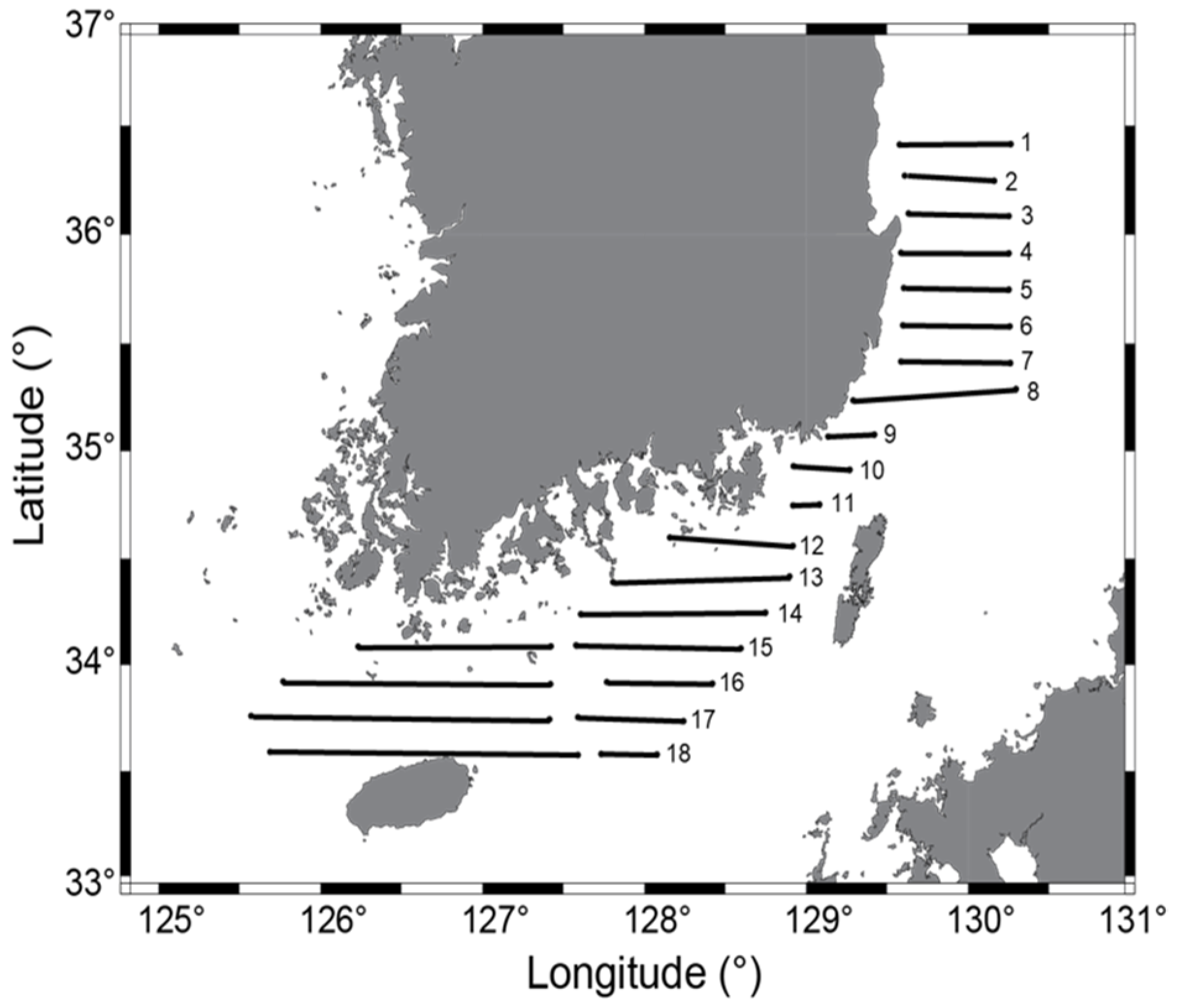
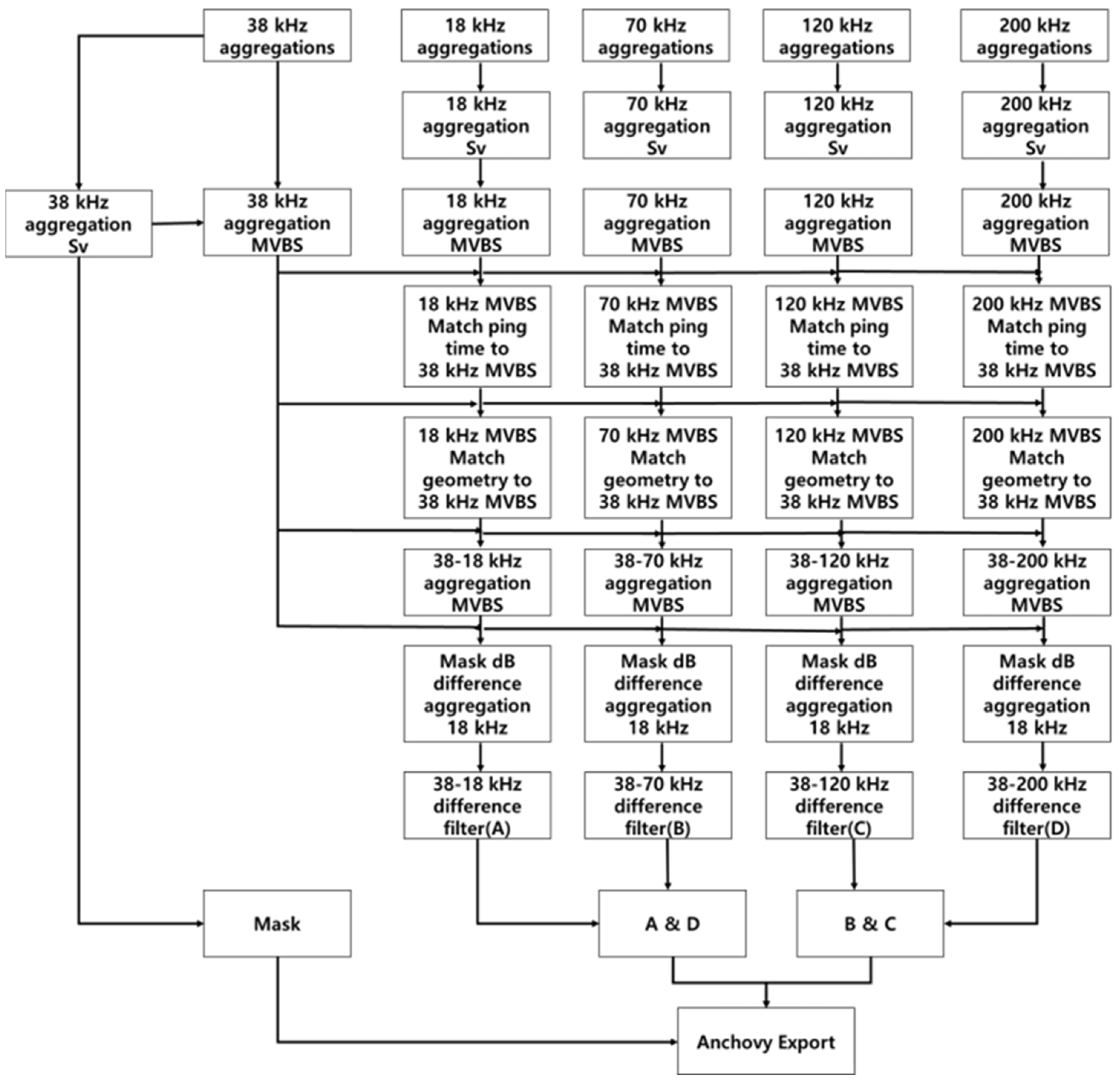
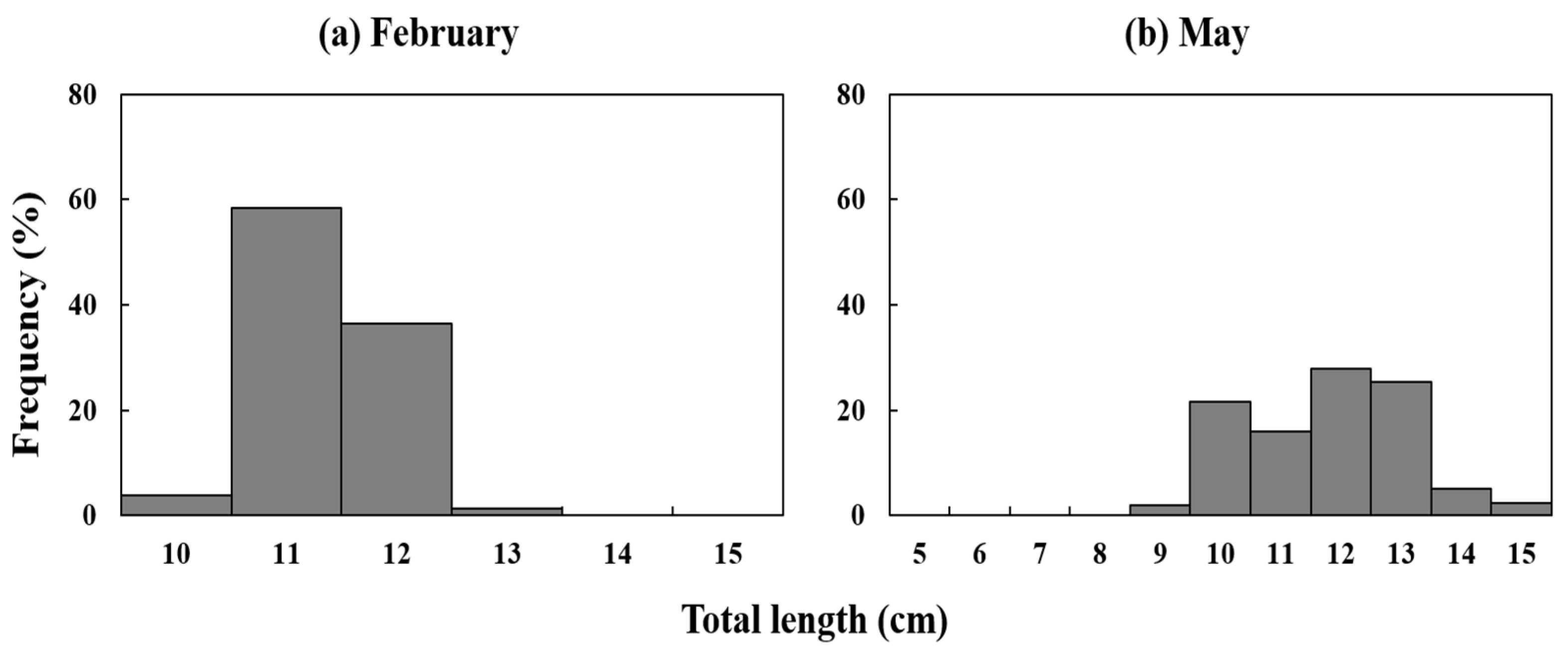
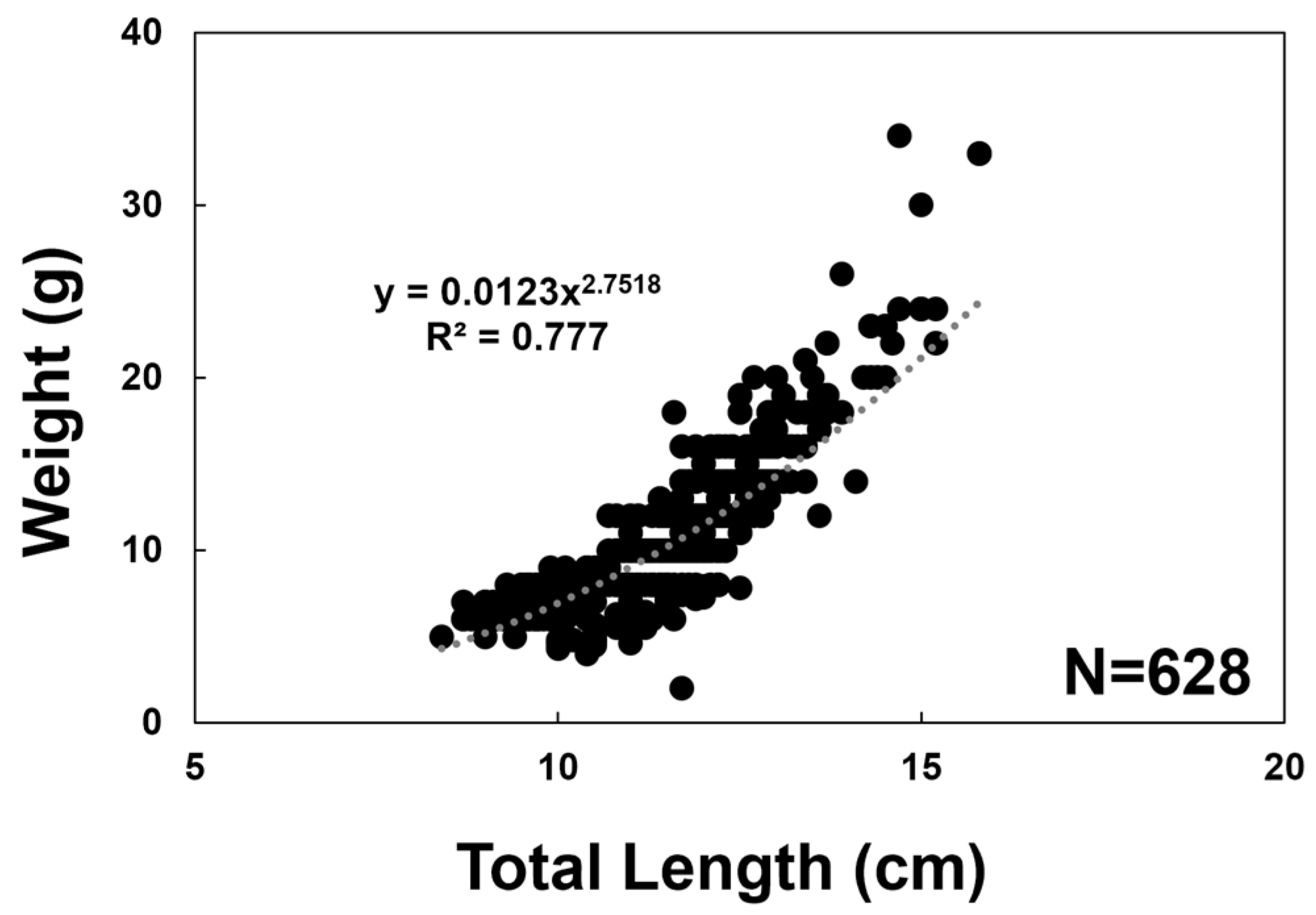
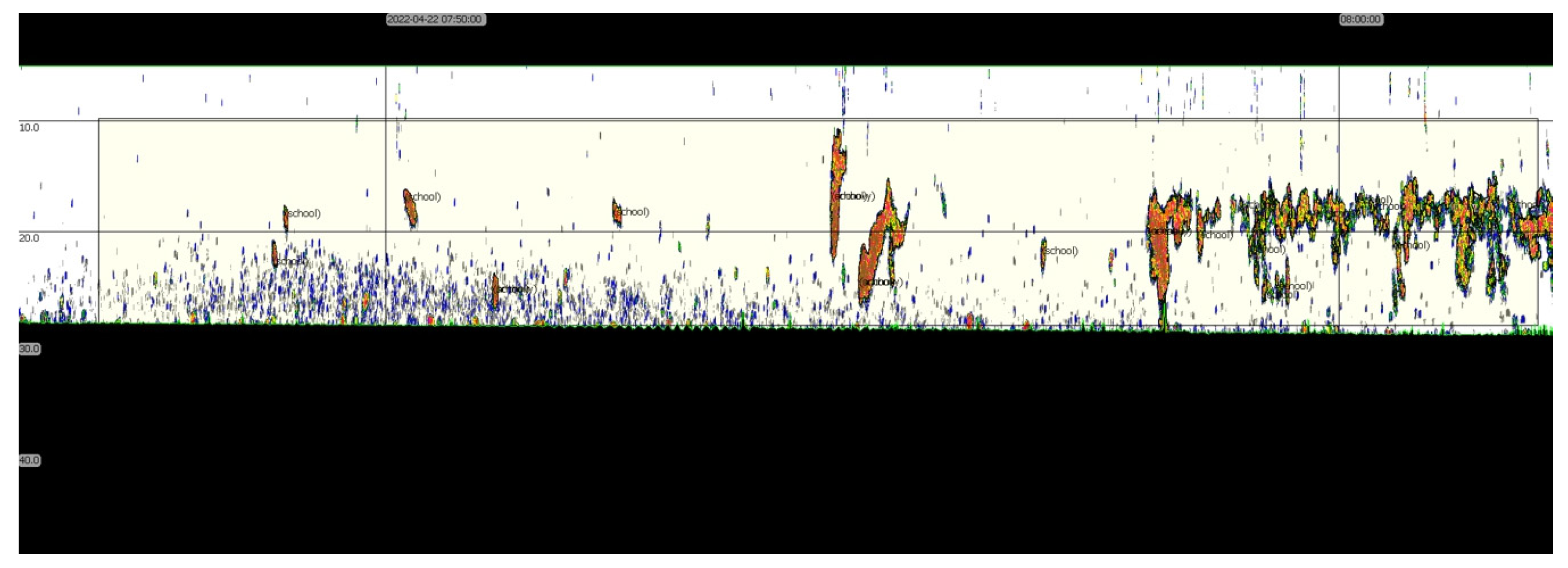
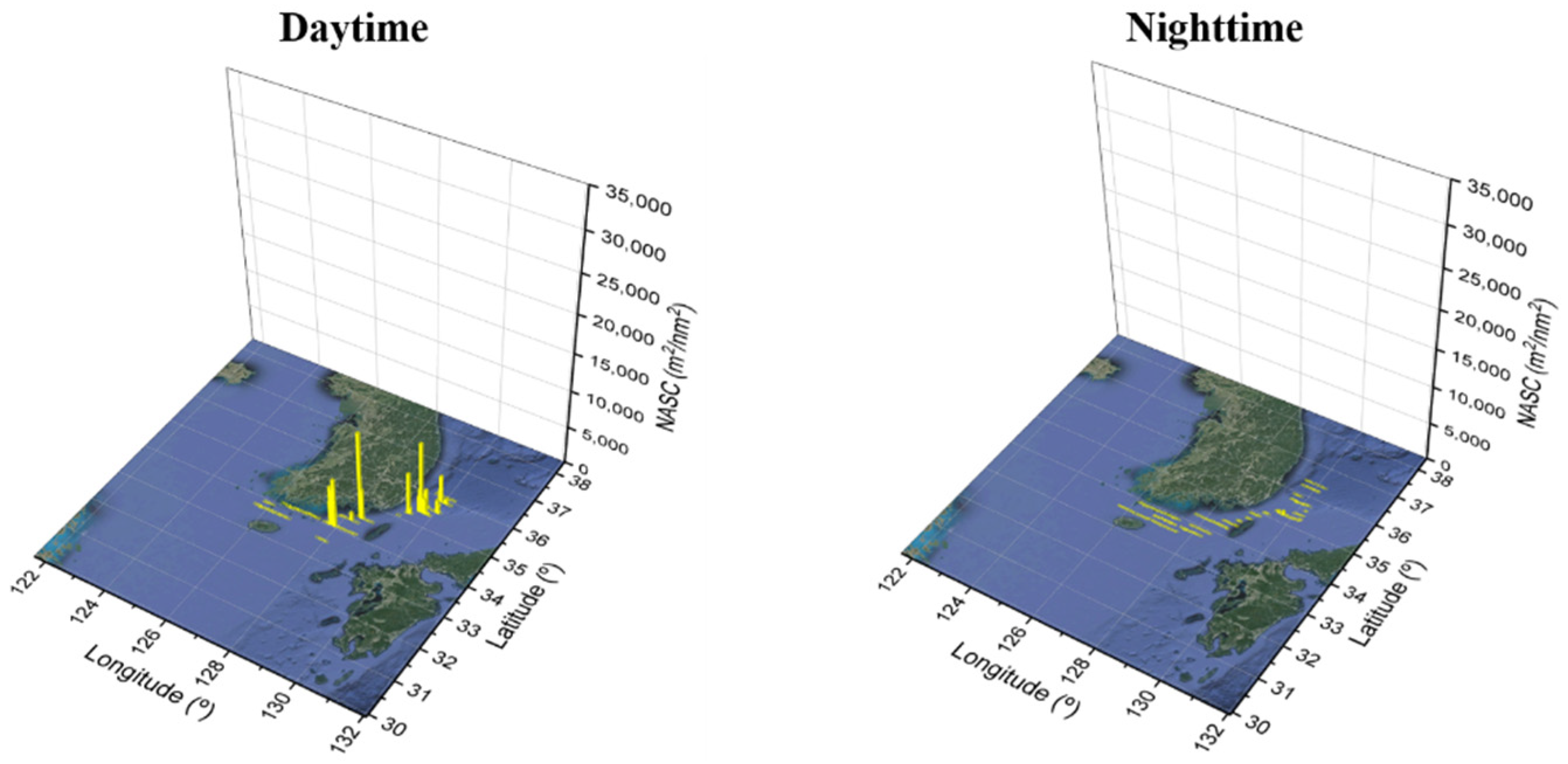

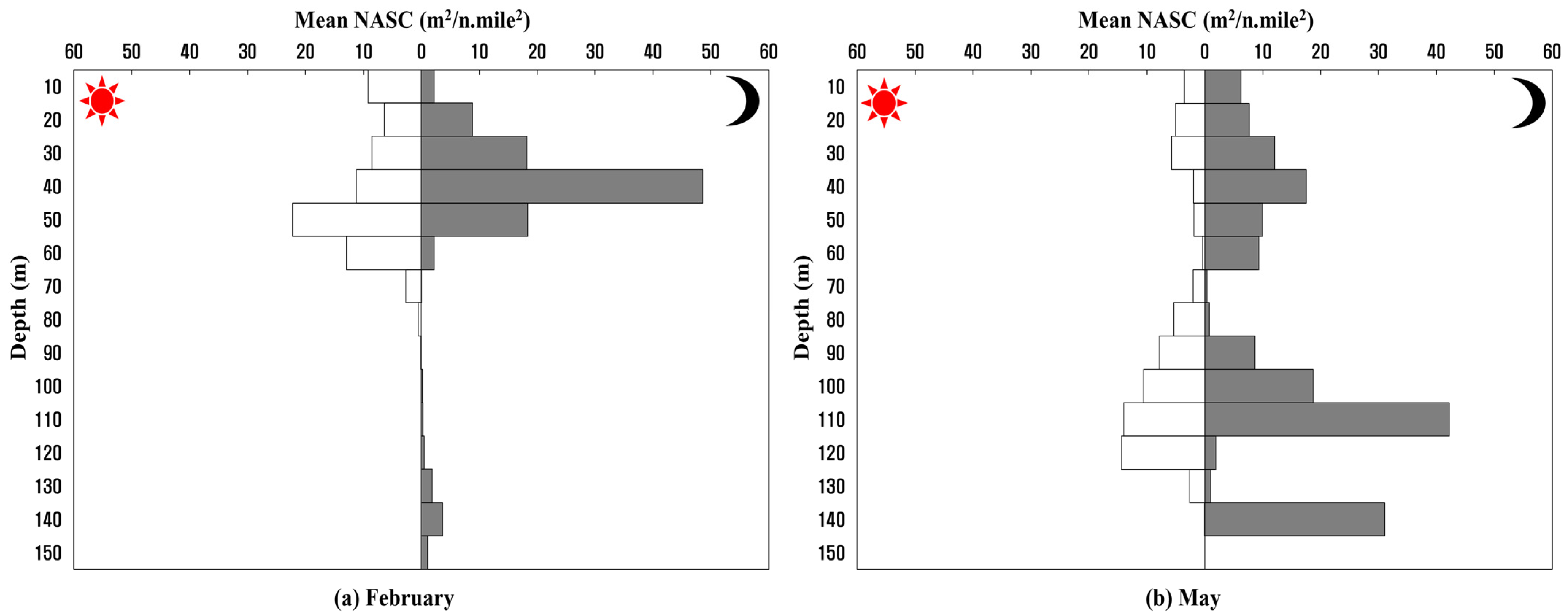
| Frequency | 18 kHz | 38 kHz | 70 kHz | 120 kHz | 200 kHz |
|---|---|---|---|---|---|
| Horizontal extent (ping) | 20 | 20 | 20 | 20 | 20 |
| Vertical units | Samples | Samples | Samples | Samples | Samples |
| Vertical extent (samples) | 5 | 5 | 5 | 5 | 5 |
| Vertical overlap (%) | 0 | 0 | 0 | 0 | 0 |
| Maximum noise (dB) | −125 | −125 | −125 | −125 | −125 |
| Minimum SNR | 10 | 10 | 10 | 10 | 10 |
| Parameters | Values |
|---|---|
| Exclude above | Surface |
| Exclude below | Bottom |
| Exclude below threshold (dB at 1 m) | −150 |
| Vertical window units | Sample |
| Vertical window size (samples) | 5 |
| Horizontal size (pings) | 5 |
| Threshold (dB) | 10 |
| Noise sample replacement value | Mean |
| Detect Parameter | |
|---|---|
| Minimun total school length (m) | 2 |
| Minimun total school height (m) | 1 |
| Minimun candidate length (m) | 1 |
| Minimun candidate height (m) | 2 |
| Maximum vertical linking distance (m) | 1 |
| Maximum horizontal linking distance (m) | 20 |
| Anchovy Classification | |
|---|---|
| SV mean (>) | −45 dB |
| Height (≥) | 1.8 |
| Corrected length (≥) | 2.6 |
| Species | Frequency (kHz) | dB-Difference (dB) |
|---|---|---|
| Anchovy (Engrailis japonicus) | 18–38 | −2.1~4.4 |
| 70–38 | −9.7~1.3 | |
| 120–38 | −10.2~2.3 | |
| 200–38 | −10.7~0.3 |
Disclaimer/Publisher’s Note: The statements, opinions and data contained in all publications are solely those of the individual author(s) and contributor(s) and not of MDPI and/or the editor(s). MDPI and/or the editor(s) disclaim responsibility for any injury to people or property resulting from any ideas, methods, instructions or products referred to in the content. |
© 2023 by the authors. Licensee MDPI, Basel, Switzerland. This article is an open access article distributed under the terms and conditions of the Creative Commons Attribution (CC BY) license (https://creativecommons.org/licenses/by/4.0/).
Share and Cite
Park, G.; Oh, W.; Yoon, E.; Lee, H.; Oh, S.; Lee, S.; Lee, C.k.; Khim, J.S.; Lee, K. Species Identification and Tempo-Spatial Distribution of Anchovy Using Multi-Frequency. J. Mar. Sci. Eng. 2023, 11, 1871. https://doi.org/10.3390/jmse11101871
Park G, Oh W, Yoon E, Lee H, Oh S, Lee S, Lee Ck, Khim JS, Lee K. Species Identification and Tempo-Spatial Distribution of Anchovy Using Multi-Frequency. Journal of Marine Science and Engineering. 2023; 11(10):1871. https://doi.org/10.3390/jmse11101871
Chicago/Turabian StylePark, Geunchang, Wooseok Oh, Euna Yoon, Hyoungbeen Lee, Sunyoung Oh, Sara Lee, Chang keun Lee, Jong Seong Khim, and Kyounghoon Lee. 2023. "Species Identification and Tempo-Spatial Distribution of Anchovy Using Multi-Frequency" Journal of Marine Science and Engineering 11, no. 10: 1871. https://doi.org/10.3390/jmse11101871
APA StylePark, G., Oh, W., Yoon, E., Lee, H., Oh, S., Lee, S., Lee, C. k., Khim, J. S., & Lee, K. (2023). Species Identification and Tempo-Spatial Distribution of Anchovy Using Multi-Frequency. Journal of Marine Science and Engineering, 11(10), 1871. https://doi.org/10.3390/jmse11101871






